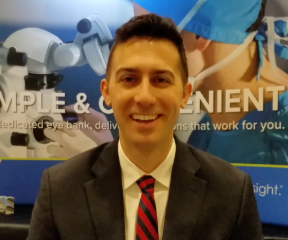
Dr. Dan Polla, ARVO 2019
Previous studies in the field of corneal transplantation have determined the importance of endothelial cell density in the health of corneal tissue grafts in terms of graft success rate. According to new research presented this week at the 2019 Annual Meeting of the Association for Research in Vision and Ophthalmology (ARVO) in Vancouver, differences in the storage media solutions can have an effect on endothelial cell density.
Through the study, a retrospective analysis was conducted on a donor database from the Kansas City-based nonprofit Saving Sight to compare eye bank donor corneal endothelial cell density (ECD) after storage in Optisol GS and Life4°C solutions. The data analyzed included 24,581 donated eye bank corneas from 2011 through 2017 stored in Optisol GS or Life4°C solutions.
This project was led by Daniel Polla, MD, Ophthalmology Resident at Montefiore Medical Center and the Albert Einstein College of Medicine Department of Ophthalmology and Visual Sciences, in collaboration with Saving Sight.
“My project looks at the different storage media solutions that donor corneas were stored in from 2011 to 2017 at Saving Sight. The preliminary findings demonstrate a small difference in endothelial cell density after storage in Optisol GS or Life4°C, with a higher ECD after storage in Optisol GS. The differences found between donor corneas in each of the storage media groups may be due to factors that were not accounted for over time such as changes in processing protocols, equipment used to measure ECD, and variability in specular microscopy. While it is possible that Optisol GS better preserves the endothelium, one potential cause for the small difference in ECD between groups is variation in endothelial cell visualization during specular microscopy due to differences in solution color,” said Dr. Polla.
“This research is important to the field of ophthalmology and corneal transplantation because it may influence the way that corneas are stored and/or evaluated prior to transplantation, ultimately leading to better graft success rates and outcomes for patients.” Dr. Polla added.
Saving Sight Chief Business Development Officer Patrick Gore, RN, CEBT, Director of Business Development Lynn Forest-Smith, and Chief Operating Officer Tina Livesay were co-authors on the study. As an eye bank that facilitates eye donation for transplant and research, the Saving Sight team is proud to support this project and to work in collaboration with Montefiore and Drs. Polla, Rand and Chuck.
“We collect a large amount of data on all of our donor cases and corneas as a part of normal operations. This was a great opportunity to have these data parameters analyzed collectively for this study. As an eye bank, this allows us to help researchers advance the field of corneal transplantation to help honor the gift of sight through better recipient outcomes,” said Tina Livesay, Saving Sight Chief Operating Officer.
This study highlights the importance of collaboration between eye banks, medical centers and researchers in advancing the fields of corneal transplantation and ophthalmology.
Abstract:
An analysis of donor corneas stored in Optisol GS and Life4°C solutions
Authors: Daniel J. Polla MD, Gabriel M. Rand MD, Patrick K. Gore RN CEBT, Lynn Forest-Smith CEBT, Tina Livesay CEBT, Roy S. Chuck MD PhD
Research Findings - ARVO 2019
Dan Polla, MD, Ophthalmology resident at Montefiore Medical Center, details his latest research study with Saving Sight that he will present at ARVO 2019.

